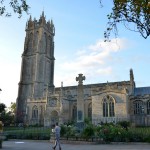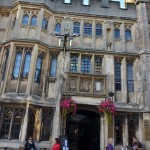 The town of Glastonbury in the county of Somerset is synonymous with many legends! The funny atmosphere of magic and sorcery is felt everywhere when you walk along the old streets, where a lot of unusual shop windows display amulets, magical costumes, candles, crystals and various occult objects as well as other things that you never imagined would be there, like Viking clothing.
The town of Glastonbury in the county of Somerset is synonymous with many legends! The funny atmosphere of magic and sorcery is felt everywhere when you walk along the old streets, where a lot of unusual shop windows display amulets, magical costumes, candles, crystals and various occult objects as well as other things that you never imagined would be there, like Viking clothing.
They say that Morgan le Fay the enchantress from the Arthurian legends dwells in this town  but nobody has ever seen her. Walking along the streets you can meet unusually dressed people with a mysterious glint in their eyes, probably magicians, travellers or simply still living in the 60’s. You can learn a lot about enchantment from the many priestesses in this town, who opened a lot occult schools invite you to sessions of trance dance, shamanic journeys and other magical rituals.
but nobody has ever seen her. Walking along the streets you can meet unusually dressed people with a mysterious glint in their eyes, probably magicians, travellers or simply still living in the 60’s. You can learn a lot about enchantment from the many priestesses in this town, who opened a lot occult schools invite you to sessions of trance dance, shamanic journeys and other magical rituals.
The ancient settlement of Glastonbury existed long before the Romans. Glastonbury Abbey is considered the oldest Christian building in the world; originally a monastery, it was built around  the 1st century, 65 years after the death of Christ, the abbey was founded in 712 and Glastonbury prospered. Thousands of pilgrims flocked there to see the tomb of St. Patrick. When the abbey was badly damaged by fire in 1184, the number of pilgrims to the town declined significantly. Suddenly, the town flourished once again when in the year 1191 the monks of the abbey found a sarcophagus on the nearby Mount of St. Michael, which were though to be that of King Arthur and his wife, Guinevere.
the 1st century, 65 years after the death of Christ, the abbey was founded in 712 and Glastonbury prospered. Thousands of pilgrims flocked there to see the tomb of St. Patrick. When the abbey was badly damaged by fire in 1184, the number of pilgrims to the town declined significantly. Suddenly, the town flourished once again when in the year 1191 the monks of the abbey found a sarcophagus on the nearby Mount of St. Michael, which were though to be that of King Arthur and his wife, Guinevere.
Glastonbury once again became a centre of pilgrimage. About that time, history had many legends. One of them is that Excalibur the sword of King Arthur was forged on this island and that Glastonbury Tor (St. Michael Mount) is the magical island of Avalon (in those days Glastonbury was surrounded by marshlands). Only the tower of St. Michael’s Church from Saxon times remains today on top of the hill, built in the 14th century on the site of the original wooden church, which was destroyed by an earthquake in 1275.
 Morgan le Fay, the goddess of war and death, who is connected with the mysterious history of Glastonbury, was the sister of King Arthur and his mistress. She taught magic on the island of Avalon. She carried off King Arthur to the island after he was mortally wounded in his last battle. They also say that, one day, when England will be in critical danger, King Arthur will wake up and save the country.
Morgan le Fay, the goddess of war and death, who is connected with the mysterious history of Glastonbury, was the sister of King Arthur and his mistress. She taught magic on the island of Avalon. She carried off King Arthur to the island after he was mortally wounded in his last battle. They also say that, one day, when England will be in critical danger, King Arthur will wake up and save the country.
The monastery was rebuilt in the 14th century and was one of the richest and most influential monasteries in England before the Reformation. In 1539 Glastonbury Abbey was abolished and the last abbot was executed on Glastonbury Tor. The town gradually lost its importance and began to decline. The Abbey buildings were destroyed and the stones were used for local construction. Up to now, the abbey remains in ruins, nevertheless it looks impressive and still attracts many tourists.
Many myths about Glastonbury, one is that the temple existed at Glastonbury before the 1st century, another, that Jesus visited this temple when he was a child. Scientists debunked these and other stories recently, including the legend of the Holy Grail, (The cup with the blood of Christ), allegedly delivered to the monastery of Glastonbury by Joseph of Arimathea, a follower of Jesus.
But these legends are now part of the history of this country and it is difficult to determine  where the legend ends and real history begins. At the present time every year before Christmas the British monarch receives a blooming branch of the Glastonbury Thorn, which is supposed to have originally grown from the staff, which Joseph of Arimathea stuck into the ground on the hill when he arrived with the Holy Grail. They also say that these thorns, which flower twice a year, only grow in Glastonbury and will not grow anywhere else.
where the legend ends and real history begins. At the present time every year before Christmas the British monarch receives a blooming branch of the Glastonbury Thorn, which is supposed to have originally grown from the staff, which Joseph of Arimathea stuck into the ground on the hill when he arrived with the Holy Grail. They also say that these thorns, which flower twice a year, only grow in Glastonbury and will not grow anywhere else.
 There is a unique phenomenon, called Fata Morgana, named after King Arthur’s sister the enchantress Morgan le Fay. It happens when in the air or on the sea fabulous mirages appear in the form of castles and wonderful scenery. The layers of air with different temperatures and densities act like giant natural lens, refracting and distorting the
There is a unique phenomenon, called Fata Morgana, named after King Arthur’s sister the enchantress Morgan le Fay. It happens when in the air or on the sea fabulous mirages appear in the form of castles and wonderful scenery. The layers of air with different temperatures and densities act like giant natural lens, refracting and distorting the sun’s rays. Under certain weather conditions, the lens’s shape can be very complicated and rays can conjure up whimsical ghosts, superimposing and multiplying several images. The same phenomenon happens sometimes on the hill of Glastonbury, consisting of terraces, where lowland moist soil can produce a visual impression as if the hill is rising out of the mist.
sun’s rays. Under certain weather conditions, the lens’s shape can be very complicated and rays can conjure up whimsical ghosts, superimposing and multiplying several images. The same phenomenon happens sometimes on the hill of Glastonbury, consisting of terraces, where lowland moist soil can produce a visual impression as if the hill is rising out of the mist.
St Michael’s Hill is mentioned in Celtic myths, Celts named the Avalon the gateway to the “Land Of The Dead”. Investigators of the Paranormal and occultists also consider Avalon as a portal to another world. Today the town is interesting for pilgrims, followers of neo-pagan beliefs, New Age religions, Sufis and other representatives of various religious groups. In fact,  Glastonbury has been called “The spiritual heart of England.”
Glastonbury has been called “The spiritual heart of England.”
Glastonbury has about 170 historic buildings; one of them is the  George&Pilgrim’s Inn, built in the late 15th century for the pilgrims to the abbey. This place is a must see historic building containing preserved carved panels with the emblems of the Abbey and Edward IV above the entrance as well the original stone floor with ancient inscriptions, not forgetting the fantastic atmosphere!
George&Pilgrim’s Inn, built in the late 15th century for the pilgrims to the abbey. This place is a must see historic building containing preserved carved panels with the emblems of the Abbey and Edward IV above the entrance as well the original stone floor with ancient inscriptions, not forgetting the fantastic atmosphere!
Finally, The West Country light Carnival procession passes through the town centre every autumn with lots of decorated trailers illuminated with thousands of electric light bulbs displaying a fantastic variety of themes. Glastonbury is now also known for one of the biggest annual music festivals in the world, attended by thousands of revellers, which is held in the open near the town since 1970 with many famous bands appearing on a huge stage in the middle of a field.



